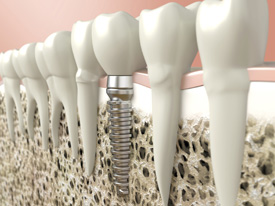 If you have lost a single tooth due to injury, health complications or gum disease, you may be able to find a permanent replacement with a single tooth implant. While you might consider a bridge as a form of dental restoration, there are many advantages to choosing a single tooth implant over a bridge.
If you have lost a single tooth due to injury, health complications or gum disease, you may be able to find a permanent replacement with a single tooth implant. While you might consider a bridge as a form of dental restoration, there are many advantages to choosing a single tooth implant over a bridge.
What Is a Single Tooth Implant?
A dental implant is a titanium fixture that can be placed in the upper or lower jaw and then capped with a dental crown in order to replace a missing tooth from the root. This is a long-term, permanent solution that can last a lifetime if you practice good oral health.
Benefits of Having a Single Tooth Implant
If you’re missing a tooth, this may not only affect your appearance, self-esteem and confidence, but it can also cause other issues. The remaining teeth may shift into the new space provided, or you can experience some degrading of facial structure. In addition, having a tooth missing can lead to issues with eating, leading to secondary health problems such as malnutrition.
Replacing a tooth with a single dental implant is a great way to counter these risks. Because the implant replaces the tooth from the root, you don’t have to worry about it falling out. It looks and functions just like your natural tooth, only you have the added benefit of not worrying about getting a cavity in that tooth!
One of the other benefits of having a single tooth implant over a dental bridge is that you don’t have to sacrifice the health of healthy neighbouring teeth. With a tooth-supported bridge, you’d have to ground down the adjacent teeth to support the bridge, which would cause problems with those teeth in the long run.
In addition, when you choose a single tooth implant, you have the advantage of better preserving the bone structure of your jaw, as the implant is fused to the bone and therefore helps to support and keep the bone healthy and intact. With a bridge, some of the bone that previously surrounded the tooth will begin to deteriorate.
Single tooth implants are also easier to keep clean than a bridge. Gums can recede around a bridge, which would leave a visible defect when the metal base of the bridge becomes exposed.
How Will the Implant Be Placed?
The process does take a while, but it’s worth it in the long run. The first step involves placing the implant screw into your jaw. The implant will bond to the bone over the next 2 to 6 months, forming an anchor for the artificial tooth. Oftentimes, another step of adding an extension to the implant will be necessary. This temporary healing cap will complete the foundation on which your new tooth will be placed. However, there are some one-step systems that use implants that already have the extension piece attached.
Finally, a dental crown will be created for you, usually made of porcelain for a more natural look. The crown will be attached to a small metal post (abutment). After a healing period, you’ll get to enjoy a restored smile and a fully functioning tooth!
If you feel you could benefit from a single tooth implant and would like to find out more about the processes involved and your suitability, please join us for a no-obligation, free consultation, by contacting Randwick Dental Clinic in Sydney.
 Randwick
Randwick